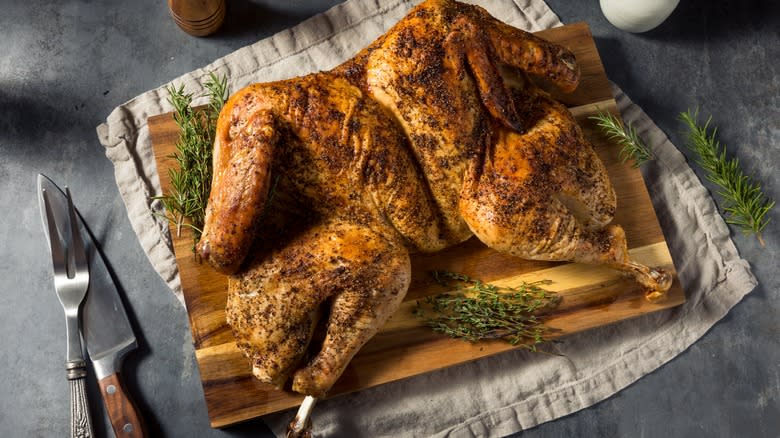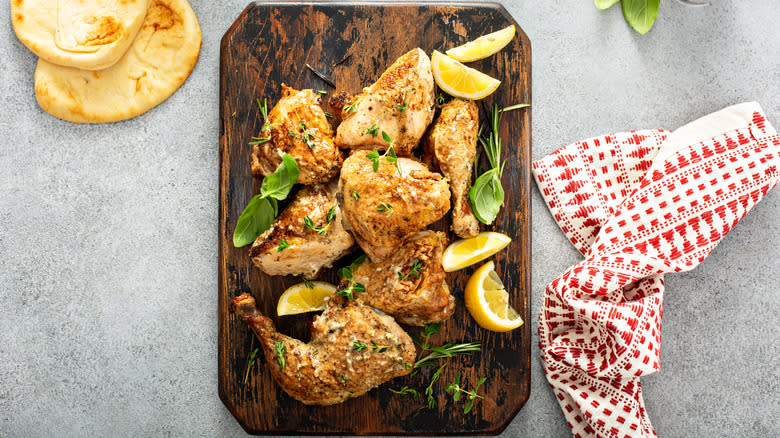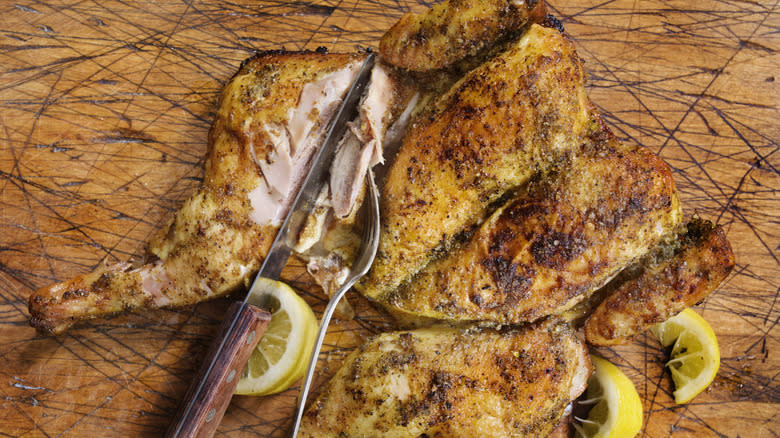What To Keep In Mind Before Carving A Spatchcocked Chicken

When you've spatchcocked and roasted a chicken, it looks a little bent out of normal chicken shape, and it can be intimidating to know where to cut. Whether it's a go-to recipe or a first-ever attempt, when you pull the beautifully seasoned chicken out of the oven, it's time to get carving. You don't want to mess up the meal by mutilating the main dish before you have a chance to serve it. Luckily, carving a spatchcocked chicken isn't as complicated as it might look.
Despite the splayed appearance of a spatchcocked chicken, the carving process is similar to that of a whole roasted chicken. What you need to keep in mind is that you will have to account for different angles as a result of the smashed anatomy, and some parts may be in slightly different places. But overall, the nature of spatchcocking means that the cuts themselves will probably be even a little easier.
Read more: 15 Tricks For Making The Most Crispy Chicken Thighs Ever
From Spatchcocking To Serving

Knowing how to spatchcock a bird is a great technique to have up your sleeve, as it can cut the roasting time in half. Spatchcocking, also sometimes called butterflying, is simply the technique of removing or cutting open the backbone of a chicken (or other poultry), and then flattening the bird. Since this alters the shape of the chicken, if you're used to carving a regular roasted bird, the steps may not be entirely intuitive. Step one is always the same though: Allow the chicken to rest for about 10 minutes. This lets the juices permeate and leads to a more moist protein.
To get started cut the skin that connects the leg and breast, then hold the leg up slightly and slice that joint. Holding that thigh you've separated, cut the joint that connects the thigh and drumstick. Then find the connective tissue for the wings, and cut between them and the breast. The flattening from spatchcocking changes the angle of the rib cage, so you'll need to use the breast bone and the cage as a guide to separate the breast meat. It may take some practice to get your platter perfect, but it'll be worth the extra time.
The Allure Of Spatchcocked Chicken

Along with shortening the roasting time, you can also grill a chicken in record time with the spatchcock technique. With the bird flattened out, the cooking time is significantly faster compared to cooking a regular whole chicken. This makes it an ideal way to cook chicken on a busy weeknight. Plus, each part of the chicken cooks more evenly -- meaning, no more digging through dried-out bits to find the perfectly juicy parts. Additionally, you'll get skin that is crispier since the heat can reach more of it.
This means a more perfectly cooked chicken every time (you can also try this technique with your holiday turkey). So now's your chance to start experimenting and practicing your spatchcocked carving with recipes like spatchcocked chicken with truffle butter and mushrooms, or spatchcocked chicken with beetroot slaw. Any delicious recipe is a great excuse to master this carving method.
Read the original article on Daily Meal

